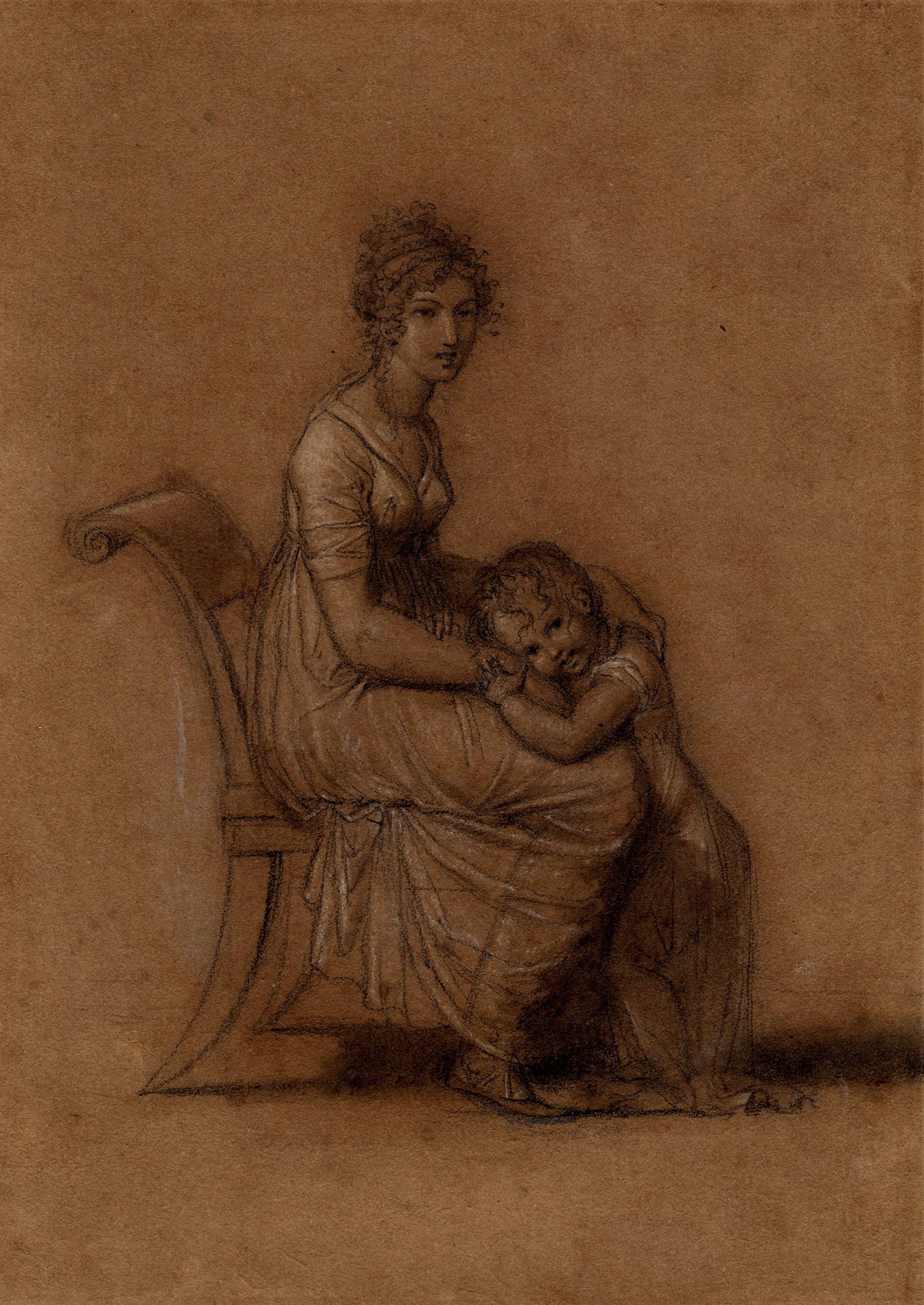Pierre-Narcisse GUERIN
(Paris 1774 - Rome or Verona 1883)
A Mother and Child
Sold
Black chalk, heightened with white chalk, on brown paper.
A slight sketch of the head of a child in black chalk on the verso.
Inscribed M.me Guérin / et [?] / Par son [?] peintre / sous Napoleon Ier / portrait donné par heritage å son élève Victor O[rsel] / dont la portion fut le quart de ses études on the backing board.
Further inscribed Guérin (Pierre-Narcise, baron) / Paris 1774 + Rome 1833 / dont le peintre Orsel 1795+1850 fut l’élève. / Le maître légua à son élève le / quart de ses études, dont ce / dessin représentant Madame Guérin / et son fils. on a label pasted onto the backing board.
239 x 163 mm. (9 3/8 x 6 3/8 in.)
A slight sketch of the head of a child in black chalk on the verso.
Inscribed M.me Guérin / et [?] / Par son [?] peintre / sous Napoleon Ier / portrait donné par heritage å son élève Victor O[rsel] / dont la portion fut le quart de ses études on the backing board.
Further inscribed Guérin (Pierre-Narcise, baron) / Paris 1774 + Rome 1833 / dont le peintre Orsel 1795+1850 fut l’élève. / Le maître légua à son élève le / quart de ses études, dont ce / dessin représentant Madame Guérin / et son fils. on a label pasted onto the backing board.
239 x 163 mm. (9 3/8 x 6 3/8 in.)
This charming and intimate portrait of a mother and child stands quite apart from the Neoclassical severity of much of Guérin’s draughtsmanship, once belonged to the artist’s pupil, assistant and heir, the painter Victor Orsel (1795-1850). Orsel had entered Guérin’s atelier in 1815 and accompanied his master to Rome in 1822. At Guérin’s death Orsel inherited a quarter of the drawings in his studio, including the present sheet, while the remainder of the drawings were distributed among several fellow pupils of the master, including Jean Alaux, Guillaume Bodinier, Léon Cogniet, Raymond Monvoisin, Alphonse Périn and Ary Scheffer.
This drawing was sold by Victor Orsel’s heirs at auction in Lyon in 1888, nearly forty years after his death, by which time it had come to be mistakenly identified as a portrait of Guérin’s wife and child. (The artist in fact remained unmarried and had no children.) It has been suggested that the drawing may instead depict the wife and child of Guérin’s close friend Pierre David, who was one of the two executors of the painter’s will.
This drawing was sold by Victor Orsel’s heirs at auction in Lyon in 1888, nearly forty years after his death, by which time it had come to be mistakenly identified as a portrait of Guérin’s wife and child. (The artist in fact remained unmarried and had no children.) It has been suggested that the drawing may instead depict the wife and child of Guérin’s close friend Pierre David, who was one of the two executors of the painter’s will.
One of the leading Neoclassical artists of his generation, Pierre-Narcisse Guérin was as a youth encouraged to consider a career as an artist by his parents. He was a pupil of Hugues Taraval and Nicolas-Guy Brenet and later studied with Jean-Baptiste Regnault. He first entered the competition for the Prix de Rome in 1793, and won the prize in 1797 with a painting of 'The Death of Cato of Utica'. Unable to leave for Rome immediately because of Napoleon’s campaign in Italy, Guérin eventually arrived at the French Academy in 1804, remaining there for two years. He sent history paintings, genre scenes and mythological subjects to the Salons from 1795 onwards, and his reputation was established early in his career with a painting of The Return of Marcus Sextus, exhibited in 1799 to much acclaim and eventually acquired by Lucien Bonaparte.
Guérin was particularly influenced by the plays of Jean Racine, and his painted compositions often display a theatrical approach. Appointed a professor at the École des Beaux-Arts in 1813, he became a highly regarded and successful teacher; his pupils included Théodore Géricault, Eugène Delacroix, Ary Scheffer, Victor Orsel and Paul Delaroche. Offered the post of Director of the French Academy in Rome in 1816, Guérin declined on the grounds that his Royal portrait commissions required him to remain in Paris. When the offer was repeated in 1822, however, he accepted, and during his six years in Rome he painted relatively few works. On his return to France in 1829 he was created a Baron by Charles X, but his declining health prompted a return to Rome, where he died soon after his arrival in 1833. His legacy continued, however, in the work of some of the succeeding generation of painters.
As one recent scholar has noted, ‘A second-generation Neoclassicist, Guérin presented a warmer, softer version of the Antique and made it a springboard for the fresh inventions of his pupils, like Gericault and Delacroix, who became Romantics.’
Provenance
Among the contents of the artist’s studio at the time of his death, and bequeathed to André-Jacques-Victor Orsel, Paris
By descent in the Orsel family, Lyon, until 1888
Orsel sale, Lyon, Hôtel des Ventes, 13-23 March 1888, lot 529 (‘Madame Guérin et son fils, portrait aux deux crayons légué par héritage à son élève Victor Orsel, sous verre, très belle pièce.’)
Anonymous sale, Paris, Hôtel Drouot, 20 May 1935, lot 122
Barbara Lowe (Mrs. Charles Henry) Fallas, Cross River, New York
Her posthumous sale, London, Christie’s, 8 July 1980, lot 60
Anonymous sale, London, Christie’s, 5 December 1989, lot 70.
Literature
Josette Bottineau and Élisabeth Foucart-Walter, ed., Archives de l’Art francais, Vol.XXXVII: L’inventaire après décès de Pierre-Narcisse Guérin, 2004, p.74.




